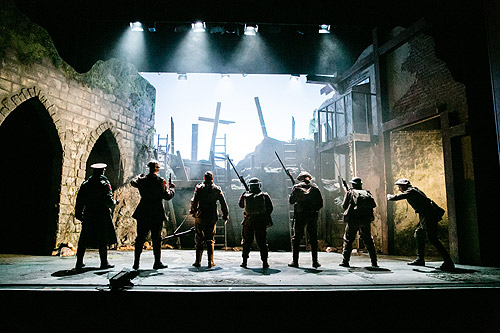
| HOME |
| NERVE |
| REVIEWS |
| ARCHIVE |
| EVENTS |
| LINKS |
| ABOUT US |
| CONTRIBUTORS |
| BACK ISSUES |
| CONTACT US |
Birdsong
Written by Sebastian Faulks, directed by Alastair Whatley
Presented by The Original Theatre Company and Birdsong Productions Ltd
Liverpool
Playhouse
14th - 18th April 2015
 Reviewed
by Colin Serjent
Reviewed
by Colin Serjent
Photograph by Jack Ladenburg
I am not a big fan of novels but Birdsong by Sebastian Faulks was an exception, and proved to be an absorbing read.
Faulk's book is over 500 pages long and encompasses several time periods and sundry locations. But for the purposes of stage production the modern voice of contemporary times is omitted.
This does not detract in any way from the dynamic and humane force of the novel, in fact it is perhaps for the best.
I must admit the love aspect, contained in the book and play, between Lieutenant Stephen Wraysford (Edmund Wiseman) and Isabelle Azaire (Emily Bowker), did not have much resonance for me, in the context of what was going on around them in the killing fields and ditches of France.
The central heart of Birdsong lies in the lives of the ordinary soldiers, the Sappers, forced to endure utter degradation, terrifying ordeals and ultra disciplinarian higher ranked soldiers. Wraysford was an exception, letting off squaddie Jack Firebrace (Peter Duncan) from a potential court martial, after, not surprisingly, falling asleep while on sentry duty, after completing a shift in the tunnels.
This act of kindness by Wraysford leads later to a friendship developing between the two of them, which notably comes to the fore as they endure insufferable conditions working in the tunnels.
The tunnels on stage were perhaps twice the height and width of those at the Somme, which were often sixty feet below ground, in which men had to crawl on their stomachs for hours on end. They were often assigned to do twelve hour stints, placing bombs under German positions.
A large proportion of the men had either previously worked excavating tunnels on behalf of the London Underground, or had worked down mines, digging out coal. But needless to say, the conditions at the Somme were more perilous to work in.
Some members of the audience around me looked perturbed whenever the loud explosions of shells being detonated took place, which gave an semblance of an idea of the ferocity, savagery and nerve jangling horrors of what the troops had to experience, hour after hour, day after day.
The scene changes were effortlessly and expertly executed, switching from and to different locations - the army hospital - where Wraysford was found to be alive after being presumed dead - the Azaire's palatial home, the bars where the French prostitutes gave sustenance to men having a brief break from the carnage at the front - can you imagine the comfort, however temporary, it must have been to have the warm embrace of a woman's body - and, of course, inside the tunnels.
The death rate of the First World War was estimated to be ten million military personnel and seven million civilians. But the utter futility of war still goes on unabated.....